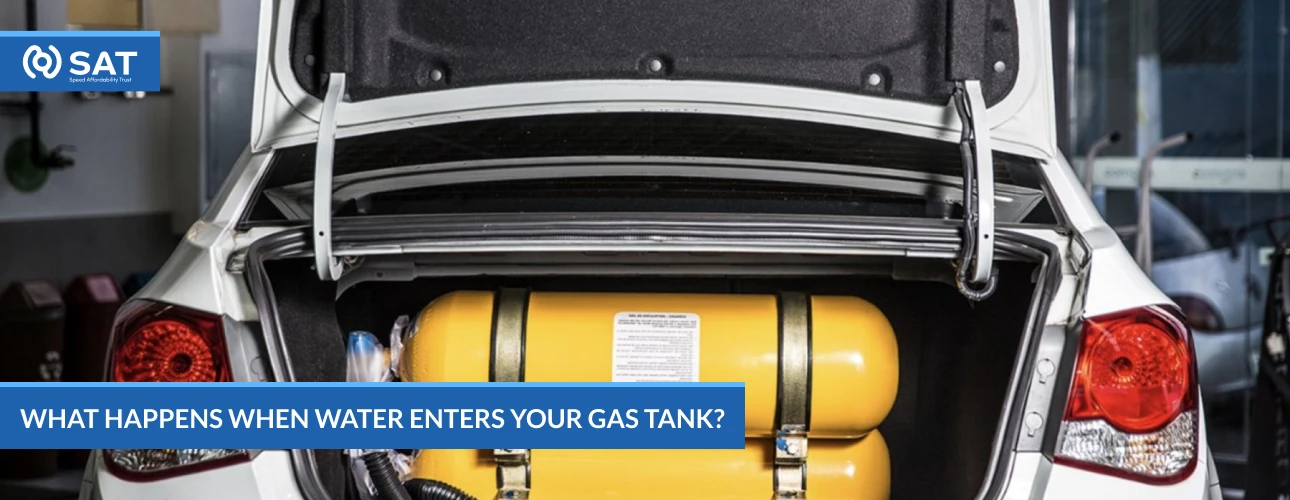In the hustle and bustle of everyday life, the most inconvenient thing to happen is your car breaking down because of an issue you deemed too minor to look into. Sometimes, instead of taking preventative measures or handling the concern immediately, drivers dismiss issues, just for them to come back ten times worse; complicating your plans and aspirations for the day.
For instance, if water were to somehow reach your engine, it may seem like a minor issue that would be solved on its own, but in reality, it can be detrimental to your vehicle’s health. Water in the car gas tank is an issue that you must stay aware of so you can rightfully identify the symptoms of dysfunction in your car and tackle it immediately. SAT Japan prioritizes all aspects of car ownership and car maintenance is no less. Hence, it is always better to stay informed about the potential issues that may occur and how to tackle them to avoid panicking at the last minute. The article below will mention the signs, symptoms and instances when water has entered into your gas tank, the damage it may cause, and how to address this concern i.e. what is the solution.
Causes Of Water Entering the Gas Tank
This should not come as a surprise that water is one of the Worst Liquids to Put in Car Gas Tank. There are many possibilities for water entering your car gas tank and knowing these will help you take precautionary measures to avoid this problem in the first place. The following are some of the most common reasons for this issue to occur:
Instances Of Water Contamination:
Consider the instances where there has been heavy rainfall in your area, to the point that cars are submerged under water, and not running anymore. For people who live in rather cold climates, used to thawing and tempering, water seeping into the gas tank is a common occurrence. One truly unlucky scenario would be if you are low on fuel and get it filled up from a petrol station that has contaminated fuel tanks. This mixed fuel will then enter your fuel tank and worsen the conditions of your vehicle’s health.
Faulty Gas Caps:
Your car gas tank is secured by a gas cap that seals your tank from the impurities outside. This gas cap is tightly clasped to prevent any contamination in the tank. One way water particles can enter your gas tank is if the gas cap is defective or not tightly clasped. In cases of rain and external water resources touching the body of the car, water will seep into the gas tank and cause problems.
Condensation in The Tank:
If you live in a humid area, or one where there is constant temperature change, there is a possibility of condensation in your gas tank. Due to the temperature changes, the air inside the tank will expand and contract causing water droplets to form due to condensation. This buildup of moisture in your car tank can lead to water contamination present in the gas tank.
Infiltration:
When there is an internal leak in the machinery and water seeps in from another part, it is called infiltration. Such an occurrence is rare but not completely zeroed out. This gradual seepage can be harmful because it is often hard to identify.
Common Symptoms When Water Enters The Tank
Finding the symptoms and signs of water in your tank is not as simple as it sounds. Since this is an internal issue, the signs will not be apparent but some tricks make it easier to diagnose your issue.
Sputtering Engine:
When you start your car or when your engine is running on the road, if there’s water present in your gas tank, your engine might start sputtering and choking up, causing unprovoked variations in the acceleration of your vehicle. The reason your engine sputters is because there is irregular combustion of different fluids and there will be dysregulation in your acceleration.
Misfires and Engine Stalling:
Recent models of vehicles use fuel injectors instead of carburetors, which inject fuel into the combustion chamber gradually. When water mixes with your fuel, these injectors experience fuel of a different consistency and density which stresses the engine and can even lead to the engine stopping abruptly.
Odd Smell From Tank:
One way to diagnose water entering your tank is when an unusual odor or smell wafts from your vehicle. If you sense an unusual odor coming from your gas tank, it means there is moisture in the tank causing issues with your engine.
What Will Happen To Your Car?
One of the most commonly known facts is that water and oil do not mix; in the case of the gasoline in your tank, no matter what form it may be, mixing with water has got to be detrimental to the inner workings of the car. Impact of Coke on your Car Engines also affects the car’s performance.
Rusting:
As the inside of your car is completely mechanical, and made of all sorts of metal, water should be the last thing entering the inner workings of your vehicle. The water causes corrosive depletion over a long while which eats through your vehicle parts. This corrosion will lead to rust and the clogging of your car’s pipes, weakening the effectiveness of your tank and causing the engine to choke on debris.
Fuel System Fails:
Water mixing into your fuel makes the effectiveness of your fuel way lower, making your engine and vehicle less efficient in its performance. With any luck, if this is the most major of your problems, it will decrease the efficiency of the fuel only, but if the matter is agitated, it can lead to loss of functionality in your engine.
How To Diagnose and Solve Water Entering The Engine?
Once you suspect that there is water in your vehicle’s tank, there are two ways to gain confirmation of this hypothesis:
Diagnosis:
Visual Confirmation:
The simpler way to detect water is by emptying a few ounces of your fuel tank into a glass. Let the glass sit for around 30 minutes, and if there is water in the fuel, it will separate and make a ring on top of the glass, confirming the entrance of water in your tank.
Water Detection Additives:
In this test, you will add a water detection additive to the top of a wooden stick and then insert the stick into your fuel tank. After a few moments, remove the dipstick to check if it has changed color. In the case of its changing color, water presence has been confirmed.
Solution Procedures:
Drain and Replace:
Once the presence of water has been diagnosed, the smartest solution is to immediately drain your tank and clean any signs of water, contaminants, and corrosion in it. Now that it is squeaky clean, you can refill your tank with fresh fuel and ensure its tip-top condition.
Water Removal Additives:
In case of water in your tank, putting specific water detector additives in the tank, made for this specific issue, will proactively bind with water molecules in your fuel and disperse them by breaking them down. This prevents the water from coagulating into bigger droplets and neutralizes the fuel tank.
Hence, it is always advised to just stick to fuel when searching for liquids to add to your gas tank. In the case that you come across any hack relating to your car, make sure to research it well to steer clear of permanently damaging its inner workings. SAT Japan does not just sell used cars, but also guides you on properly maintaining them; hence, the tips above will help you understand the reason why adding water to your gas tank can be detrimental to your car engine’s health.




